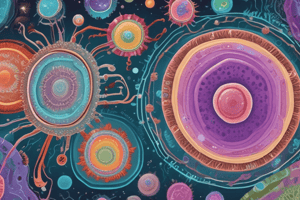Podcast
Questions and Answers
What is the primary function of the periplasmic space in gram-negative bacteria?
What is the primary function of the periplasmic space in gram-negative bacteria?
- To regulate the expression of type III secretion devices
- To facilitate the breakdown of large macromolecules for metabolism (correct)
- To produce teichoic acids
- To synthesize peptidoglycan layers
What is a characteristic of the outer membrane in gram-negative bacteria?
What is a characteristic of the outer membrane in gram-negative bacteria?
- It contains lipoteichoic acids
- It is traversed by type I to V secretion devices (correct)
- It is composed of a thick peptidoglycan layer
- It is unique to gram-positive bacteria
What is the primary function of lipoteichoic acids in gram-positive bacteria?
What is the primary function of lipoteichoic acids in gram-positive bacteria?
- To synthesize the peptidoglycan layer
- To initiate innate protective host responses (correct)
- To transport molecules across the cell wall
- To regulate the expression of virulence factors
What is a characteristic of the gram-negative cell wall?
What is a characteristic of the gram-negative cell wall?
What is the primary function of type III secretion devices in gram-negative bacteria?
What is the primary function of type III secretion devices in gram-negative bacteria?
What is the main function of the peptidoglycan in gram-positive bacteria?
What is the main function of the peptidoglycan in gram-positive bacteria?
What is the effect of lysozyme on the peptidoglycan of gram-positive bacteria?
What is the effect of lysozyme on the peptidoglycan of gram-positive bacteria?
Which of the following molecules is NOT a component of the gram-positive bacterial cell wall?
Which of the following molecules is NOT a component of the gram-positive bacterial cell wall?
What is the role of lipoteichoic acids in gram-positive bacteria?
What is the role of lipoteichoic acids in gram-positive bacteria?
What is the consequence of removing the peptidoglycan layer from a gram-positive bacterium?
What is the consequence of removing the peptidoglycan layer from a gram-positive bacterium?
Flashcards are hidden until you start studying
Study Notes
Gram-Positive Bacteria
- A gram-positive bacterium has a thick, multilayered cell wall consisting mainly of peptidoglycan (150 to 500 Å) surrounding the cytoplasmic membrane.
- The peptidoglycan is a meshlike exoskeleton that allows diffusion of metabolites to the plasma membrane.
- The peptidoglycan is essential for structure, replication, and survival in hostile conditions.
- Lysozyme, an enzyme found in human tears and mucus, can degrade peptidoglycan, leading to bacterial lysis.
- The gram-positive cell wall may include other components such as proteins, teichoic and lipoteichoic acids, and complex polysaccharides.
- Virulence proteins, such as the M protein of streptococci and protein A of S. aureus, are covalently bound to the peptidoglycan.
- Teichoic acids are water-soluble anionic polymers of polyol phosphates that are covalently linked to the peptidoglycan and essential to cell viability.
- Lipoteichoic acids have a fatty acid and are anchored in the cytoplasmic membrane.
Gram-Negative Bacteria
- Gram-negative cell walls are more complex than gram-positive cell walls, both structurally and chemically.
- The gram-negative cell wall contains a thin peptidoglycan layer (5-10% of the cell wall by weight) and an outer membrane.
- There are no teichoic or lipoteichoic acids in the gram-negative cell wall.
- The outer membrane contains a periplasmic space with transport systems for iron, proteins, sugars, and other metabolites, as well as hydrolytic enzymes.
- The periplasmic space contains virulence factors such as collagenases, hyaluronidases, proteases, and β-lactamase in pathogenic gram-negative species.
- The gram-negative cell wall also contains type I to V secretion devices that provide mechanisms for the uptake and release of different metabolites and other compounds.
Studying That Suits You
Use AI to generate personalized quizzes and flashcards to suit your learning preferences.




